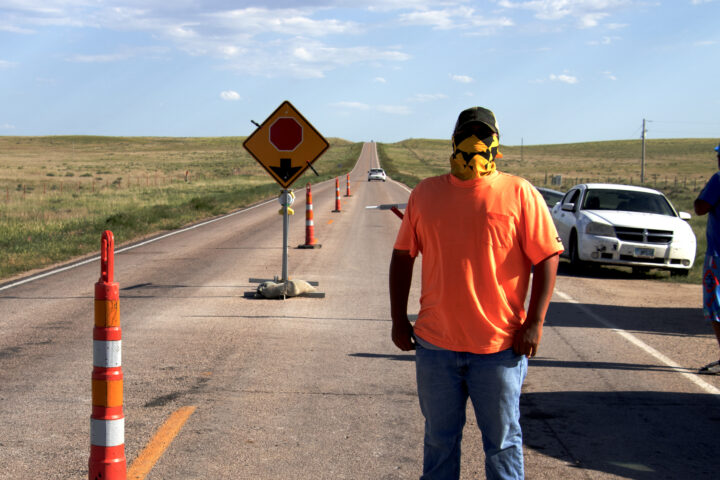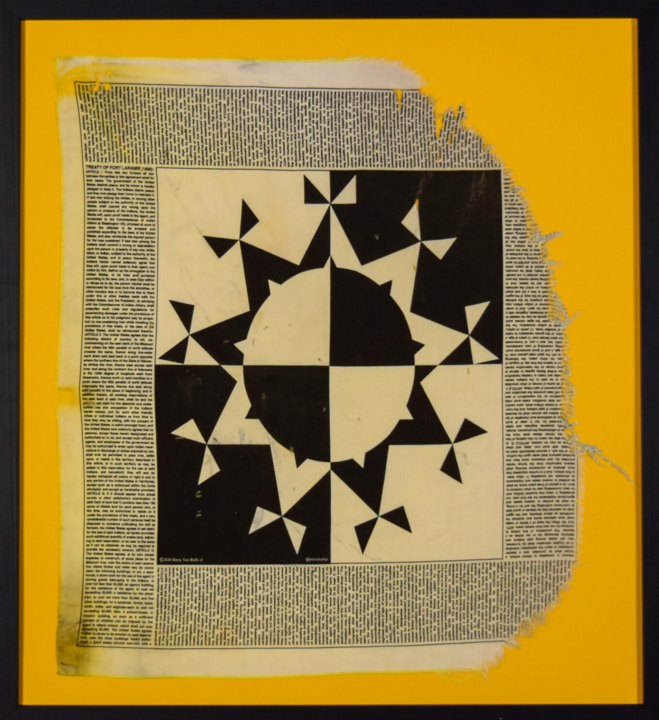Vol. 35.1 Spring/Summer 2024
In our Spring/Summer 2024 issue, Buzz Spector, our Art Editor, carefully selected works that explore the theme of property and individuality within shared spaces. Daniel Georges’ “Lot Lines” photographs capture the subtle ways residents personalize their nearly identical rowhouses in Brooklyn, offering a visual commentary on the balance between conformity and personal expression. Meanwhile, Marty Two Bulls Jr.’s Lakota Quarantine Flag, featured on our cover, powerfully represents the ongoing struggle for sovereignty and land rights during the COVID-19 pandemic. Together, these works highlight the intersection of property, tradition, and survival in today’s world.
For more insight into these selections and the vision behind them, be sure to read our Art Editor’s note below.
Vol. 35.1 — Art Editor’s Note by Buzz Spector
Every issue of december is an interplay, in text and image, of ideas and sensations. The former is the purview of all the arts, while the latter begins with taking hold of the physical object and moving one’s fingers to turn its pages. In this way, reading is like entering a building, where one must start by opening a door. Unlike reading an individual’s work of poetry or prose, which might find architectural equivalence in a house, reading a magazine is closer to, say, an apartment complex or shopping mall. No, let me correct this analogy on the spot; opening this magazine is like walking down a street lined with rowhouses, each, in turn, sharing structural attributes—walls as words, facades as pictures—with its neighbors, but also reflective of the differences—social, political, ideological, demographic—between one family or individual and the next. This is a hospitable street, you understand, with everyone amenable to your entrance.
The Belgian poet/artist/provocateur, Marcel Broodthaers (1924-1976), made linguistic/imagistic interplay his central concern. Broodthaers’ “architecture,” though, began with a natural analogy to rowhouses, colonies of mussels. For him, such clusters of shellfish were also so many self-contained worlds, each the product of a creature living in its own casting. In a 1961 poem, “The Mussel” the title in French punningly joins le moule (mussel) with la moule (a cast or mould):
This clever thing has avoided society’s mould.
She’s cast herself in her very own.
Other look-alikes share with her the anti-sea.
She’s perfect.
I recalled Broodthaers while looking at the “Lot Lines” photographs of Daniel Georges. This sculptor and photographer brings the sensibility of a flâneur to his walks through Brooklyn’s Williamsburg neighborhood, noting the ways that inhabitants of adjoining rowhouses embellish their dwellings to make them stand out. Georges offers us juxtapositions but not judgments in the “Lot Lines” photographs. From counterpointed imitation stone, brick, or aluminum siding, through differing styles of window grates or front stairways, to the plants or statues visible on windowsills, a paradoxically shared freedom of expression inspires the people who reside in these formulaic urban dwellings. Georges adumbrates their proximal architectural distinctions, bringing our eyes to differing styles of transoms or gateposts, say, or statuary versus plants on otherwise identical windows. His real focus, though, is on the property lines that cognitively, if not physically, separate each rowhouse from the next. In so doing, Georges divines a punning situation of his own, of properties of properties that are markers of ways home.
Where there is want, there is property. Any tangible thing can be property, but wanting to have something is never just a matter of flesh, even when the desire is carnal. Of all categories of property, the ownership of land is most fraught. The everywhere carnage of the moment is bound up in contested proprietary claims, with appeals to tradition, heritage, and ideology waved like rhetorical flags on poles, ready to be plunged into this or that earthly, or lunar, soil. Social—hence human—forces may lay claim to lands, but nature exerts its own powers in this regard, through visible disasters like tornados or floods, or invisible (read: epidemiological) catastrophes like COVID-19.
Where there is want, there is property. Any tangible thing can be property, but wanting to have something is never just a matter of flesh, even when the desire is carnal. Of all categories of property, the ownership of land is most fraught. The everywhere carnage of the moment is bound up in contested proprietary claims, with appeals to tradition, heritage, and ideology waved like rhetorical flags on poles, ready to be plunged into this or that earthly, or lunar, soil. Social—hence human—forces may lay claim to lands, but nature exerts its own powers in this regard, through visible disasters like tornados or floods, or invisible (read: epidemiological) catastrophes like COVID-19.
The United States is only recently past legislating COVID-19 protocols (a different matter than being past COVID infections), but the clash between the Oglala Sioux Tribe and the state government of South Dakota, at the height of the pandemic, over the tribal quarantine of the Pine Ridge Indian Reservation, pitted tribal safety against the State’s political preferences. Pine Ridge Indian Reservation is one of the poorest counties in the United States, with limited health resources to cope with the pandemic. Marty Two Bulls Jr., an enrolled member of the Oglala Sioux Tribe, brought his art and advocacy to support the sovereign rights of his tribe. The Lakota Quarantine Flag on our cover, designed by Two Bulls Jr., was given to health checkpoint workers in 2020, where it flew over a post at Redshirt Table, South Dakota. Its black and yellow checkered motif is an international signal for quarantine. The design is a palimpsest of the Oglala Sioux Tribe flag over this quarantine motif. The flag’s border contains the complete wording of 1868 Fort Laramie Treaty, the document that confirms tribal ownership of their lands. The artist states, “These bandanas are a tangible symbol of the rights and resolve of the Lakota people.”
Marty Two Bulls Jr. is an artist and educator based in Rapid City, South Dakota. He is an enrolled member of the Oglala Sioux Tribe and was raised in the high plains of South Dakota. He grew up in his father’s studio, where he learned the fundamentals of sculpture, illustration, graphic design, and, most important, how to make a living as a creative person. He studied printmaking and ceramics at The Institute of American Indian Arts. He teaches at Oglala Lakota College (OLC) and has exhibited his artwork nationally and internationally in galleries and museums, with works in several museum’s permanent collections.
Daniel Georges received an MFA in sculpture from School of Visual Arts, New York, and studied photography at International Center of Photography in New York. He has been producing and exhibiting photography since 2016. He has shown photos and sculpture widely, organized exhibitions, and built, renovated and managed buildings in New York and Oregon. He was based in Williamsburg, Brooklyn until moving recently to Newburgh in the Hudson Valley.


